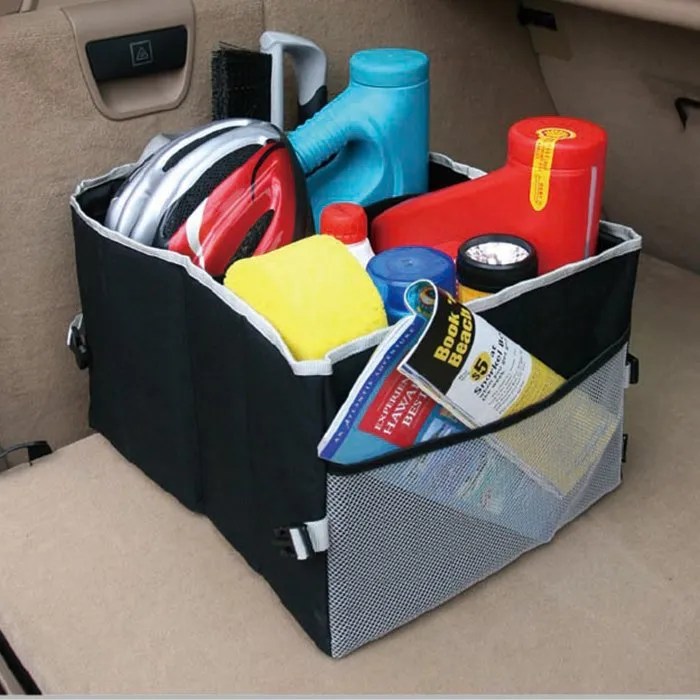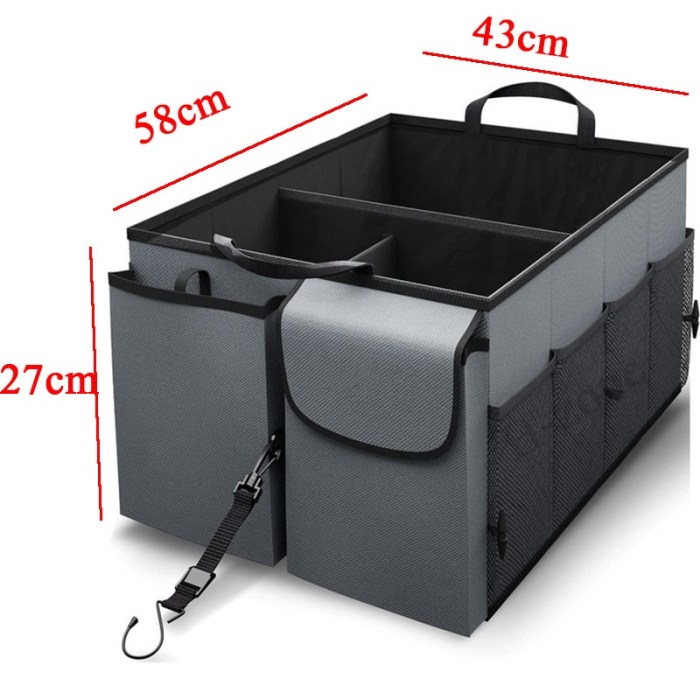Car organizers for small trunk space? Yeah, that’s a real thing, and a lifesaver if you’re constantly battling clutter in your ride. We’re talking about maximizing every inch of that tiny trunk, transforming it from a chaotic mess into an organized oasis. This guide dives into the world of trunk organizers, covering everything from choosing the right type and size to clever storage strategies and even some DIY solutions to help you conquer your car’s storage woes.
From fabric bins to hard-shell containers, we’ll explore different options, weigh the pros and cons, and show you how to measure your trunk to find the perfect fit. We’ll also tackle common organizational challenges, like fitting groceries, sports gear, and tools, while offering tips on securing items so they don’t go flying around during your next road trip. Get ready to reclaim your trunk space!
Types of Car Organizers for Small Trunks
So, you’ve got a tiny trunk and a mountain of stuff to haul around? Don’t despair! There are tons of car organizers designed specifically for smaller spaces, maximizing every inch. Choosing the right one depends on your needs and preferences, so let’s break down the options.
Car Organizer Types by Material and Features
The type of car organizer you choose will greatly impact its durability, ease of cleaning, and overall effectiveness in your small trunk. Consider the material carefully based on your priorities.
| Type | Material | Pros | Cons |
|---|---|---|---|
| Collapsible Trunk Organizer | Fabric (often polyester or nylon) | Lightweight, easy to store when not in use, relatively inexpensive, often comes in various sizes and configurations. | Less durable than hard-shell options, may not be as water-resistant, can be prone to sagging if overfilled. |
| Hard-Shell Trunk Organizer | Plastic (often polypropylene) | Durable, water-resistant, maintains its shape even when fully loaded, often features dividers and compartments. | Heavier than fabric organizers, less flexible in terms of shape and size, can be more expensive. |
| Under-Seat Organizers | Fabric or Plastic | Maximizes under-seat space, ideal for smaller items like cleaning supplies, tools, or emergency kits. Keeps items out of the main trunk space. | Limited capacity, may not be suitable for larger or heavier items, can interfere with seat adjustments depending on the design. |
| Trunk Divider/Shelf System | Plastic or Metal | Creates separate compartments within the trunk, preventing items from shifting and improving organization. Can be adjusted to fit different trunk sizes. | Can be more expensive, may reduce overall trunk capacity depending on the design and placement. |
Space-Saving Design Elements in Car Organizers
Many car organizers for small trunks incorporate clever design features to maximize storage space. These features often include expandable designs, stackable units, and flexible dividers that can be adjusted to fit different sized items. For example, a collapsible fabric organizer can be folded flat for easy storage when not needed, freeing up valuable space. Hard-shell organizers often include clever interlocking systems that allow for stacking or nesting, further optimizing space.
Many organizers also incorporate elastic straps or pockets for securing smaller items and preventing them from shifting around.
Comparison of Organizer Types: Capacity, Durability, and Ease of Use
Fabric organizers generally offer greater flexibility and ease of use, but sacrifice durability compared to hard-shell options. Hard-shell organizers provide superior protection and sturdiness, but might be less adaptable to irregularly shaped items. The capacity of each type depends heavily on the specific design and dimensions. A large, hard-shell organizer might offer more overall capacity, but a well-designed fabric organizer with multiple compartments can actually be more efficient for storing a variety of smaller items.
Ultimately, the best choice depends on your individual needs and priorities. Consider what you plan to store, how much space you have, and your budget when making your decision.
Space-Saving Strategies and Techniques
Optimizing your car’s trunk space, especially in smaller vehicles, requires a strategic approach. Effective organization isn’t just about fitting more stuff in; it’s about making that stuff easily accessible and preventing items from shifting during travel. This section explores practical techniques and visual aids to help you maximize your trunk’s potential.
Efficient trunk organization hinges on utilizing every inch of available space. This means thinking vertically, strategically stacking items, and choosing organizers perfectly tailored to your trunk’s dimensions. Ignoring these principles often leads to wasted space and frustration. Let’s explore how to avoid this.
Maximizing Trunk Space with Car Organizers: A Visual Guide
Imagine your trunk as a three-dimensional puzzle. A visual representation would show a small trunk (perhaps 2ft x 3ft x 1.5ft) initially cluttered with randomly placed items: a gym bag, groceries, a toolbox, and miscellaneous sporting equipment. This initial image highlights the chaotic and inefficient use of space. The next image shows the same trunk, but now organized.
A sturdy, collapsible storage bin sits at the base, containing heavier items like the toolbox. Above it, a slim, vertical organizer holds cleaning supplies and smaller tools. On the side, a hanging organizer keeps groceries upright and prevents them from rolling around. The gym bag is neatly tucked in a corner, leaving ample space above it.
The final image is a top-down view showcasing how the organizers create distinct zones, maximizing both vertical and horizontal space. The overall impression is one of order and efficiency, a stark contrast to the first image. This demonstrates how thoughtful use of organizers can transform a chaotic space into a highly functional one.
Seriously, car organizers are a lifesaver, especially if you’ve got a tiny trunk. Finding ways to maximize space is key, and sometimes that means needing a car in the first place! If your credit’s a little, uh, challenged (like, a 500 score), check out resources like Subprime auto lenders for 500 credit score to help you get on the road.
Then, once you’ve got your ride, those organizers will be your best friend for keeping everything neat and tidy.
Vertical Space Utilization and Stacking Techniques
Effective trunk organization requires leveraging vertical space. Instead of simply placing items on the floor, consider using stackable bins or organizers that create vertical layers. For example, you can place a shallow bin containing smaller items on top of a larger bin holding heavier items. This technique maximizes space and prevents items from shifting. Further enhancing this, utilizing slim, vertical organizers specifically designed for small trunks can create additional storage for items like cleaning supplies or emergency kits.
Remember, stacking should be done strategically, with heavier items at the bottom to maintain stability and prevent damage to more fragile items.
Importance of Organizers Matching Trunk Dimensions
Choosing organizers that precisely fit your trunk’s dimensions is crucial for maximizing space and preventing wasted areas. Measuring your trunk’s length, width, and height beforehand allows you to select organizers that perfectly fill the available space, avoiding gaps that lead to wasted potential. For example, a trunk measuring 3 feet wide and 2 feet deep might benefit from two 1.5-foot-wide organizers placed side-by-side, instead of a single larger one that might leave empty space on the sides.
Failing to do this pre-measurement step can significantly reduce the overall effectiveness of your organization system.
Organizing Different Items in a Small Trunk

Optimizing your car’s trunk space, especially when dealing with a smaller-than-average model, requires a strategic approach to organization. Efficiently storing various items prevents shifting during travel, improves accessibility, and keeps your trunk neat and functional. This section will Artikel effective methods for organizing common trunk items.
Proper organization is key to maximizing space and preventing damage to your belongings. By carefully selecting storage solutions and employing space-saving techniques, you can easily accommodate even a surprising amount of cargo in a small trunk.
Common Trunk Items and Their Organization
Let’s consider some frequently stored items and how to best organize them in a compact trunk. Remember, vertical space is your friend!
- Groceries: Use reusable grocery bags, keeping heavier items at the bottom. Consider collapsible storage bins to keep things separated and prevent spills. A cooler bag can help maintain perishable goods’ temperature.
- Sporting Equipment: Bags designed for specific sports (golf clubs, hockey sticks, etc.) often offer the best space-saving solutions. If you have multiple pieces of equipment, consider using straps or bungee cords to secure them together and prevent shifting. For smaller items like tennis balls or soccer balls, use a dedicated container to prevent them from rolling around.
- Tools: A rolling toolbox or a well-organized tool bag is ideal for keeping tools contained and accessible. Consider using foam inserts or dividers within the tool bag to prevent tools from scratching each other or shifting during transport. Heavier tools should be placed at the bottom of the bag or container for better stability.
- Emergency Kit: Keep your emergency kit in a readily accessible, clearly marked container. This could include a first-aid kit, jumper cables, flares, and a flashlight. Having a designated spot for this essential kit will ensure quick access in case of an emergency.
- Other Items: For miscellaneous items like cleaning supplies or car accessories, use smaller, stackable containers. This allows for efficient use of vertical space and keeps items categorized and contained.
Organizing Groceries, Sporting Equipment, and Tools
Let’s look at specific examples of organizing these common trunk items.
Groceries: Imagine a trip to the grocery store. Instead of loose bags, place items in reusable bags, grouping similar items together (e.g., produce, canned goods). Heavier items, like bottled water, go at the bottom. Consider using a collapsible fabric bin to further organize and prevent spills. A cooler bag on top will keep your perishables fresh.
Sporting Equipment: Think about transporting a set of golf clubs. A golf bag is designed to efficiently hold the clubs, keeping them upright and protected. For smaller items like tennis balls, use a small container to keep them from rolling around. If transporting multiple pieces of equipment, use straps or bungee cords to secure them together and prevent them from moving.
Tools: A rolling toolbox is ideal for a set of tools, keeping them organized and preventing damage. If you have a smaller set of tools, a well-organized tool bag with dividers will suffice. Heavier tools should always be placed at the bottom of the container for better stability and to prevent the bag from tipping.
Securing Items to Prevent Shifting, Car organizers for small trunk space
Keeping your trunk’s contents secure is vital for safety and preventing damage to your car and belongings. Here are some effective techniques:
- Bungee cords: These are versatile and inexpensive, ideal for securing larger items like sporting equipment or luggage. Loop them around the items and anchor them to the trunk’s tie-down points (if available).
- Cargo nets: These stretchy nets create a barrier, preventing smaller items from rolling around. They are particularly useful for groceries or loose tools.
- Adjustable straps: Similar to bungee cords, adjustable straps provide more secure fastening for heavier items. Ensure they are tightly fastened to the items and the trunk’s secure points.
- Non-slip mats: Placing a non-slip mat on the trunk floor prevents items from sliding. This is especially helpful when transporting delicate items.
- Storage containers with lids: Using containers with secure lids prevents items from spilling or shifting. Choose containers that are sturdy and stackable for optimal space utilization.
Materials and Durability Considerations
Choosing the right materials for your car trunk organizer is crucial for its longevity and effectiveness. The material you select will directly impact how well it withstands daily wear and tear, protects your belongings, and even how easy it is to clean. Different materials offer various advantages and disadvantages, so understanding these differences is key to making an informed purchase.The durability and water resistance of a car organizer are largely determined by the materials used in its construction.
Fabric, plastic, and metal are common choices, each with its own set of pros and cons. The weight and fragility of the items you intend to store should also influence your material selection. For instance, fragile items like electronics might require more padding and a sturdier container than heavier, less delicate items.
Material Properties and Suitability
Fabric organizers, often made from nylon or polyester, are lightweight and relatively inexpensive. They tend to be flexible and can conform to the shape of your trunk, making them a good option for irregular spaces. However, fabric organizers generally offer less protection against impacts and are not water-resistant unless treated specifically. They are ideal for lightweight, non-fragile items like clothes or soft toys.
Their lifespan depends heavily on the quality of the fabric and stitching; lower-quality fabrics may tear or fray easily, while high-quality ones can last for several years with proper care. Regular cleaning is usually straightforward, often involving a simple wipe-down or machine wash (depending on the care instructions).Plastic organizers, usually made from polypropylene or polyethylene, are generally more durable and water-resistant than fabric ones.
They offer better protection against impacts and can often handle heavier items. Hard plastic organizers are less flexible and may not fit as snugly into irregular trunk spaces. They are suitable for a wider range of items, including tools, groceries, and sporting equipment. The lifespan of a plastic organizer is typically longer than a fabric one, but they can crack or break if subjected to significant impacts or extreme temperatures.
Cleaning is usually easy, with a simple wipe-down often sufficient.Metal organizers, typically made from steel or aluminum, are the most durable and offer the highest level of protection. They can handle extremely heavy items and are generally very resistant to damage. However, they are also the heaviest and least flexible option, making them less suitable for smaller trunks or irregularly shaped spaces.
Metal organizers are excellent for storing heavy tools or equipment, but their weight can be a significant drawback. Metal organizers are usually quite resistant to water, although rust can be a concern if not properly treated. Their lifespan is generally very long, but they may require occasional maintenance such as rust prevention treatment.
Lifespan and Maintenance
The lifespan of a car organizer depends significantly on the material, quality of construction, and frequency of use. A well-made fabric organizer might last a couple of years with moderate use, while a high-quality plastic organizer could last for five years or more. Metal organizers, if properly maintained, can potentially last for a decade or longer. Regular cleaning and proper storage are crucial for extending the life of any car organizer.
Fabric organizers may require occasional spot cleaning or machine washing, while plastic and metal organizers usually only need to be wiped down. Avoiding exposure to extreme temperatures and direct sunlight can also help prevent damage and extend the life of your organizer.
Finding the Right Size and Fit
Choosing the right car organizer is crucial for maximizing your trunk’s limited space. A poorly fitting organizer can be just as frustrating as having no organizer at all, leading to wasted space and difficulty accessing your belongings. Accurate measurements and careful consideration of your trunk’s shape are key to finding the perfect fit.Getting the dimensions right is the first step to successful trunk organization.
So, you’re struggling with limited trunk space? Car organizers are a lifesaver, but maximizing that space is key to keeping your car looking clean and organized. Knowing how to return your leased car in tip-top shape is also crucial, which is why checking out this article on How to avoid lease disposition fees is a smart move; avoiding those fees frees up cash for more car organizers! Then you can really optimize that tiny trunk for maximum efficiency.
Don’t just eyeball it; grab a tape measure and meticulously record the length, width, and depth of your trunk’s usable space. Remember to account for any wheel wells, spare tire, or other permanent fixtures that might restrict the organizer’s placement. Consider measuring the space in several areas to account for variations in shape. For example, the depth might be shallower near the rear bumper than in the center of the trunk.
You might even want to create a rough sketch of your trunk, noting these measurements and obstructions.
Trunk Space Measurement and Organizer Selection
Before purchasing any organizer, accurately measure your trunk’s interior. Measure the length, width, and height of the usable space, taking note of any intrusions like wheel wells or the spare tire. Compare these measurements to the dimensions of potential organizers. Look for organizers that are slightly smaller than your measurements to allow for easy installation and removal, and to avoid a too-tight fit that could damage your car’s interior.
Consider organizers with adjustable dividers or expandable designs for greater flexibility in accommodating various item sizes. For example, if your trunk measures 40 inches long by 30 inches wide, you would want to select an organizer that is slightly smaller, perhaps 38 inches long by 28 inches wide, to allow for a comfortable fit and easy access.
Installing and Removing Car Organizers
Installing most car organizers is straightforward. Many organizers utilize straps, hooks, or other simple fastening mechanisms that attach to existing features within the trunk. Carefully read the manufacturer’s instructions before beginning installation. Some organizers might require you to place them in a specific order to ensure proper stability. For example, a multi-compartment organizer might require the base to be installed first, followed by the individual compartments.
Always ensure the organizer is securely fastened to prevent it from shifting during driving. Removing the organizer is usually just as easy; simply unfasten the straps or hooks and lift the organizer out. If the organizer is heavy or unwieldy, ask for help to prevent injury or damage to the organizer or your vehicle.
Budget-Friendly Options and DIY Solutions
Keeping your trunk organized on a budget is totally doable! There are plenty of affordable car organizers available, and with a little creativity, you can even make your own. This section explores both store-bought bargains and DIY projects to help you maximize your trunk space without breaking the bank.
Affordable Car Organizers from Various Retailers
You can find budget-friendly car organizers at a variety of places. Discount stores often carry basic trunk organizers made from durable materials like polyester or heavy-duty canvas. These usually come in a range of sizes and colors, providing a practical and affordable solution. Online marketplaces also offer a huge selection, often with competitive pricing and frequent sales. Finally, many auto parts stores carry a selection of organizers, sometimes featuring their own store brands at lower price points than name brands.
These options usually offer a balance between price and functionality, making them a good choice for those on a budget.
Creating a Simple DIY Car Organizer
Building your own car organizer is a great way to save money and customize the solution to your exact needs. This example uses readily available materials and requires minimal crafting skills.
Materials:
- A sturdy cardboard box (like a shoebox or a slightly larger box, depending on your needs)
- Fabric remnants (canvas, denim, or even heavy-duty felt work well)
- Hot glue gun and glue sticks
- Scissors
- Measuring tape
- Optional: Decorative fabric, ribbon, or other embellishments
Step-by-Step Instructions:
- Measure your trunk space and cut the cardboard box to the desired size and shape. Ensure it fits snugly and won’t slide around.
- Measure and cut the fabric, adding extra for seam allowances (about 1/2 inch on each side). The fabric should be large enough to completely cover the cardboard box.
- Apply hot glue to the edges of the cardboard box and carefully attach the fabric, pulling it taut to avoid wrinkles.
- Trim any excess fabric and use hot glue to secure the edges neatly.
- Optional: Add decorative elements like ribbon or fabric patches to personalize your organizer.
Cost-Effectiveness Comparison: DIY vs. Store-Bought
The cost-effectiveness of DIY versus store-bought car organizers depends on several factors. Store-bought organizers offer convenience and immediate use, but their price can vary widely depending on features and brand. A simple, basic organizer might cost between $15 and $30, while more elaborate ones can cost significantly more. DIY organizers, on the other hand, utilize materials you may already have, minimizing upfront costs.
The primary expense would be the fabric and potentially a hot glue gun if you don’t already own one. However, the time investment in creating a DIY organizer needs to be considered. For someone with limited time, a store-bought option might be more efficient, even if slightly more expensive. For those with crafting skills and readily available materials, a DIY solution can offer significant cost savings.
Ultimately, the best choice depends on individual needs, available resources, and time constraints.
Final Conclusion: Car Organizers For Small Trunk Space

So, ditch the overflowing trunk and embrace the power of organization! With a little planning and the right car organizer, even the smallest trunk can become a marvel of efficiency. Remember to consider your needs, measure your space, and choose materials that suit your lifestyle. Whether you opt for a store-bought solution or unleash your inner DIY guru, the key is finding a system that works for you and keeps your car tidy.
Happy organizing!









